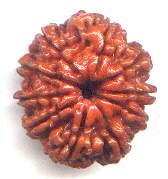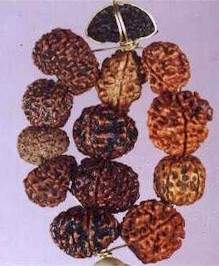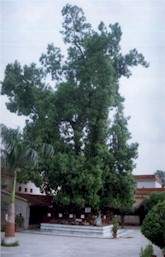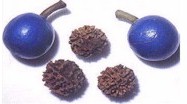 |
|
  |
Rudraksha is the favourite bead of Siva. It is believed that they remove all
the sins by sight, contact and Japas.  One who wears the
rudraksha in the prescribed manner will invoke the energies of Lord Siva. Rudraksha is to
Siva like Salagrama to Vishnu. One who wears the
rudraksha in the prescribed manner will invoke the energies of Lord Siva. Rudraksha is to
Siva like Salagrama to Vishnu.
According to Siva in Rudraksha balopanisad, all
people should wear Rudraksha in colors associated with their own varnas (castes). These
colors are white, red, yellow and black for Brahmins,
Kshatriyas, Vaishyas and Shudras respectively.
The bead and the Tree |

|
 The rudraksha bead is the dried fruit of the tree Elaeocarpus Ganitrus. The rudraksa trees are grown in
Nepal (home land), Dehrahdun, Himalayas and Indonesia. These trees are said to have
spontaneously generated from the tears of Lord Siva. Once Siva had been performing
penance for thousands of divine years. When he finally emerged from this state and
opened his eyes, the deep joy, peace, and love he felt for the human race was expressed
with sacred tears which ran down his cheek and fell to earth. From those tear drops, the Rudraksha plants were born. They
are large trees with a wide silhouette whose flowers bloom annually. The
Rudraksh trees are also called bead trees, as their seeds have natural perforation along
their axis, which facilitates making Rudraksh rosary. The rudraksha bead is the dried fruit of the tree Elaeocarpus Ganitrus. The rudraksa trees are grown in
Nepal (home land), Dehrahdun, Himalayas and Indonesia. These trees are said to have
spontaneously generated from the tears of Lord Siva. Once Siva had been performing
penance for thousands of divine years. When he finally emerged from this state and
opened his eyes, the deep joy, peace, and love he felt for the human race was expressed
with sacred tears which ran down his cheek and fell to earth. From those tear drops, the Rudraksha plants were born. They
are large trees with a wide silhouette whose flowers bloom annually. The
Rudraksh trees are also called bead trees, as their seeds have natural perforation along
their axis, which facilitates making Rudraksh rosary.
The rudraksha berry varies in size (3-40 mm).
Rudraksha berry is covered by outer shell of blue color on fully ripening, so it is also
called as blueberry beads which is very sweet in eating and can be used for varieties of
treatment for indigestion, vomiting, cut injuries etc.
 Lodged within the pulp of the
berry is a single round bead which has a rough surface and a hole running through it from
top to bottom. Rudraksha beads come mainly in light brown color but as the age of
Rudraksha increases, the color changes from brown to black. Each bead possess from 1 to 21
vertical lines running down its surface, like the longitude lines on a globe. These lines are known as mukhis or facets and are natural formations
of the seed. Each mukhi outside represent a seed inside. Lodged within the pulp of the
berry is a single round bead which has a rough surface and a hole running through it from
top to bottom. Rudraksha beads come mainly in light brown color but as the age of
Rudraksha increases, the color changes from brown to black. Each bead possess from 1 to 21
vertical lines running down its surface, like the longitude lines on a globe. These lines are known as mukhis or facets and are natural formations
of the seed. Each mukhi outside represent a seed inside.
 Seeds with one
vertical line are known as ek-mukhi (one facet); those with two lines are dwi-mukhi (two
facets) and so on. Five Mukh to Fourteen Mukh Rudraksh seeds are of
common occurrence, while others are uncommon. Ekmukhi Rudraksh seed is
most rare and is held in utmost respect. Only 50 to 100 Rudraksh fruits from a tree
are single faced and are thus very difficult to search from the thousands of multi-faced
Rudraksh fruits. The rudraksha bead has a very long lifespan. A properly cared bead
can be passed along to eight generations. Seeds with one
vertical line are known as ek-mukhi (one facet); those with two lines are dwi-mukhi (two
facets) and so on. Five Mukh to Fourteen Mukh Rudraksh seeds are of
common occurrence, while others are uncommon. Ekmukhi Rudraksh seed is
most rare and is held in utmost respect. Only 50 to 100 Rudraksh fruits from a tree
are single faced and are thus very difficult to search from the thousands of multi-faced
Rudraksh fruits. The rudraksha bead has a very long lifespan. A properly cared bead
can be passed along to eight generations.
IDENTIFICATION OF A REAL
RUDRAKSHA
Artificial Rudraksha is often made from the wild
berry seeds or nuts. But these berries cannot be made as real as the ones that are in the
genuine ones and therefore easily be detected by an experienced eye. Looking at the deep
linings-facets one can recognize real Rudraksha. There are some simple tests to
distinguish the real Rudraksha from fake one, though there is no fullproof method. A real
bead does not float the surface of water or milk. The best quality Rudraksha is a little
greasy, rounded, hard, with protuberant mouth, clear face, and with a natural hole.
It is seen that even an unripe but genuine
Rudraksha may float in the water, and a non-genuine ones made out of wood impregnated with
lead may sink. Therefore, before buying a Rudrakasha one should consult a reliable and an
experienced person. The five-faced Rudrakasha are very commonly found and therefore are
mostly the real ones. Rudraksha having 2,3,4,6,7 or 8 faces can also be found easily but
its price is more than the five-faced Rudrakshas. Generally the Rudrakasha sold in the
market are real ones as they are available in abundance in nature but the Rudrakasha that
are of rare kind (like ek-mukhi) are prepared artificially in order to meet the increasing
demand.
Be particularly careful about ever purchasing a
one-faced rudraksha. Round ek-mukhis are not currently available in nature at all . No
tree in India, Nepal or Indonesia has produced ek-mukhi in the past few decades. Only if
one acquires one which has been passed down from generation to generation might it be
possible to find this exceedingly rare object.
Also, if you find rudrakshas offered at very low
prices, it is unlikely to be authentic. Many fake rudrakshas are being fashioned today out
of wild berries, betel nut, lotus seed, polyvinyl plastic, and other materials. Skilled
artists draw artificial mukhis on these surfaces and thus try to give them a real
appearance. There are no accurate tests to identify real beads except with examination by
an experienced eye.
Astrological Beliefs
The following are the specific attributes of the
beads of various mukhis (lines or facets):
Facets |
Representation
|
Belief
|
| 1 |
Shiva |
Extremely
rare and equally expensive. It represents the Siva himself. Its wearer is bestowed with
worldly comfort and spiritual fulfillment. |
2
|
Ardhnareeshwar |
Fosters
harmony and oneness between those who are divided. Extremely rare. Given to couple at
marriage. |
3
|
Agni
|
Helps
dispel mental lethargy and depression. Attracts wealth. |
| 4 |
Brahma
|
The
wearer gains power of creativity when blessed. Increases memory power, wit and
intelligence |
| 5 |
Kalaagni
Rudra |
The
fullest representation of Rudra. It will give the wearer peace of mind and clarity of
purpose. Helps to achieve one’s goals. All malas which are worn around the neck or
used as japa mala should be of five mukhi. The count should be 108 or 54. |
| 6 |
Kartikeya
|
The one
worn by soldiers, police, adventurers, and all persons exposed to danger. It protects one
from harm and instills calm and will power in the wearer. It represents Lord Kartikeya. |
| 7 |
Mahalaxmi
|
Stated
to be abode of Laxmi. This rudraksha is not worn, but rather is kept in a wooden box
together with a small sum of cash. It will help overcome financial hardship and bring
abundance. |
| 8 |
Ganesh |
Removes
all obstacles and brings success in all undertakings. It gives the wearer all kinds of
attainments - Riddhies and Siddhies . |
| 9 |
Durga |
Help
motivate a person who is experiencing mental inertia (tamas). Protects one’s children
from misfortune. |
| 10 |
Vishnu |
This
contains the influence of ten incarnations and the ten directions. It works like a shield
on one's body and drives evils away. Protects the wearer from those people and things that
may harm him. |
| 11 |
Hanuman |
It
promotes excellent general physical and mental health, gives insight and vision, and
deflects evil thoughts. Increases energy, power, and mental stamina. |
| 12 |
Sun |
Wearer
gets the quality of the sun - to rule and to move continuously with brilliant radiance and
strength. The wearer will have the attention and respect of the world and be presented
with opportunity. |
| 13 |
Indra |
Showers
all possible comforts of life one can ever desire. It gives riches and honor and fulfills
all the earthly desires. Kamadeva pleases with the man who wears it. |
| 14 |
Hanuman |
This
bead is worn only on the forehead in a special headband, after being blessed by a priest
in a special puja ceremony. It is said to activate the ajna chakra (third eye) and bestow
subtle vision and intuitive powers. |
| 15 - 21 |
Lord
Pashupati |
Should
be kept as a set of seven beads on the personal prayer location or house where they will
bring health, peace, and prosperity to the family. This also protects from any kinds of
skin diseases. |
|
